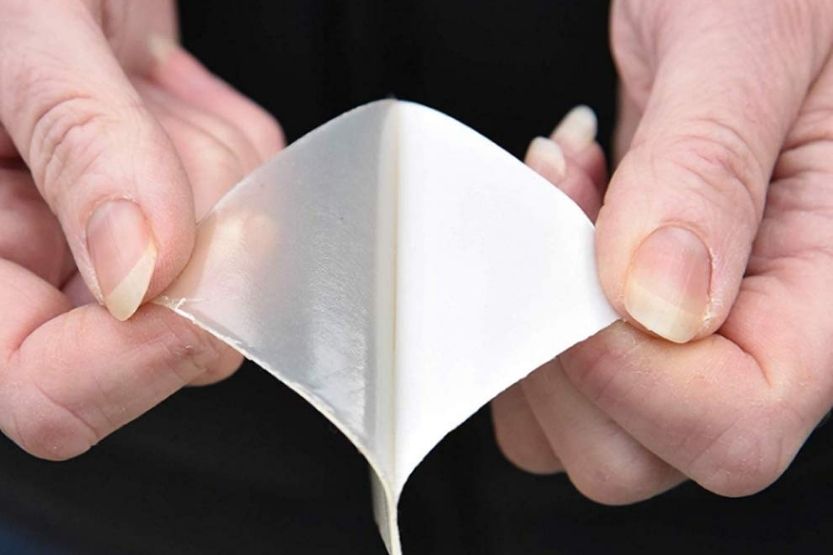Are you looking for an air-tight and mess-free sealing material that is also flexible and strong? There’s one adhesive that can do all these things – butyl tape. What is butyl tape?
Butyl tape is a pressure-sensitive adhesive tape from synthetic rubber. Its adhesive component is made of substances formulated in the lab and not from natural resins from the rubber tree. This tape is very sticky because rubber adhesives have a high initial tack. It can instantly adhere to most surfaces.
Butyl tape can provide insulation between a thin pane of glass and its frame of metal, wood, or hard plastic. It can help the glass to remain tight inside the frame. Just one layer of butyl tape can protect a window from losing the heat inside the room. It can also prevent the outside cold from coming in.
Read on to learn more about what a butyl tape is, where you can use it, its benefits, and its pros and cons.
Also, take a look at our recommended butyl tape, the SUNLL Adhesive Butyl Tape, on Amazon, to see its great price and reviews:
Click here to see it on Amazon.
What Is Butyl Tape?

Butyl tape is a pressure-sensitive adhesive tape (PSA) that is made of synthetic rubber. Its adhesive is formulated in the lab. The rubber adhesive of this tape has a high initial tack that makes them very sticky. That’s why they can adhere instantly to most surfaces.
There are different kinds of adhesive tape:
- Rubber-based,
- Silicone-based, and
- Some are acrylic-based.
Butyl tape is made of synthetic rubber with adhesive substances that are formulated in the laboratory.
Butyl was developed to enhance the properties of natural rubber adhesives. Unlike other adhesive tapes, butyl tapes are not sensitive to temperature. They are also able to maintain their tackiness at low temperatures better than natural rubber.
Butyl tapes are strong adhesive tapes that are typically used when an absolute sealing effect is required. Its major components are butyl rubber and polyisobutene blended to create a solid and tacky adhesive property.
Butyl Tape Uses and Benefits
Provide Insulation
Butyl seal tape is handy because it can provide insulation between a thin pane of glass and its metal, wood, or plastic frame. Just one layer of butyl tape is needed to protect a glass window from losing the heat inside a room. It will also prevent the cold from outside from getting inside the room.
Sealing Capacity
The great sealing capacity of a butyl rubber sealant tape enables it to be used as an effective waterproofing material. Water and moisture are prevented from penetrating surfaces that are protected with butyl tape.
Butyl tape is also very flexible. It will not harden when applied and is amazingly tenacious in its grip. This is why it is a great material for repairing and sealing parts and surfaces of boats always submerged in water.
Butyl tape is great for sealing parts and surfaces of vehicles. It can be your quick sealing and waterproofing material for the seals and seams on the roof of your RV. If there are any leaks in your fuel and vacuum lines, you can use this tape to seal them.
The strong adhesive is surface attached to isolation papers which are shaped in rolls. Just like other tapes, butyl tape is available in rolls that are several feet long. They are also called butyl waterproof sealing adhesive tape.
Good Choice for Bonding Applications Where Moisture Is a Problem
These special tapes are a good choice for bonding applications where moisture is the main problem. They are very effective in bonding materials that are non-porous and have smooth surfaces, such as glasses, metals, and plastics.
Used in Automotive
You can use butyl tape in the following:
- Automotive interior waterproof sealing,
- Doors and windows,
- Ventilation pipes,
- Steel structure roof color steel plate,
- Dust removal equipment,
- Roof concrete,
- Lighting plates lapped, and many more.
Butyl Tape Types and Sizes

Butyl tapes come in different types and sizes. Each type and size is made for a specific application. The different types of butyl tapes include the following:
1. Single-Sided Tape
This butyl tape has strong adhesive only on one of its sides. It is the side that you need to attach to the surface that you want to seal. The other side functions as its face or cover. It is sometimes called self-adhesive sealing tape.
This tape can be used as the external anti-corrosion protective seal of steel and metal pipes, cable joints, steel pipelines with high voltage wires, pollution discharge, petroleum drainage, and similar industrial applications.
2. Double-Sided Tape
This butyl seal tape has strong adhesives on both sides. Some tapes are non-toxic, non-shrinking, and with no solvents. These tapes are temperature resistant up to 90°C. They are also called high temperature-resistant sealing adhesive tape.
As such, you can use these tapes in roof waterproofing, water supply and drainage projects, waterproofing of underground facilities, and sealing of culverts and tunnels. Moreover, you can also use them in sealing and waterproofing sedimentation and treatment tanks’ joints.
3. Sizes
Butyl tape is so flexible that they make it into different sizes and shapes. Their shapes and dimensions are straightforward to customize so that they can fit a certain application. But in general, these tapes are available in different lengths and widths.
The most common type that is used in the United States is double-sided butyl tape. They are available per roll or in multi-packs. The most common butyl tape sizes are the following:
- 1/2 inch wide, 1/16 inches thick, available as rolls from 35 to 100 feet
- 3/4 inch wide, 1/16 inches thick, available as rolls from 35 to 100 feet
- 3/4 inch wide, 1/8 inches, available as rolls from 35 to 100 feet
- 1 inch wide, 1/8 inches thick, available as rolls from 35 to 100 feet
4. Colors
Butyl tapes are generally available in three colors, black, gray, and white. The choice of color usually depends on the application. There is a color-coding system that industries follow when using tapes for sealing and waterproofing. You should also follow this system for safety purposes, even if you used butyl tape for your house or your vehicle.
Butyl Tape for Vehicles
Butyl tapes can be handy to vehicle owners. You don’t know when a leak will occur in your RV or your car. Sometimes it can happen at a time when you least expect it. Having a roll of butyl tape in your car trunk will give you peace of mind.
Anytime a leak occurs anywhere in your vehicle, you have something that can instantly stop that leak. Use it to stop a leak on your fuel line, as a gasket between two vibrating panels, or as a gap on the vehicle’s firewall.
Butyl rubber sealant tape is a great material for RV DIY projects. Its putty-like properties are the reason behind its other name, dum-dum tape. However, this tape is easier to work with than putty and is not as messy. You can use it to hold fuel lines away from hot engine parts to prevent accidents.
It is very effective in creating seals along the perimeter of sunroofs. These tapes are also the preferred material of caravan manufacturers. You can use this tape in sealing the joints; the body works molding, outer skins, and other vehicle sections.
Butyl Tape for RV Windows
You can use butyl tape as the replacement for the original sealant around the windows of an RV. Most probably, the original non-butyl putty has become hard and brittle due to exposure to elements.
Thus, the seal can no longer provide the required barrier. It will allow moisture to seep into the RV interior and cause water damage to its interior walls. You need to replace the original but already degraded putty seal with a new one to protect the RV interior.
To do that, you have first to remove the windows, remove the worn-out seals, and install new butyl tape seals. The work involved is not that difficult, but you need a helper to remove the windows from their frames. A simple screwdriver is enough to remove these windows.
Steps to Follow
- Remove all the screws that hold the window frames to the trailer or RV wall.
- Remove and loosen all the original putty from each window.
- Lift each window carefully out of the wall opening.
- Clean the window frames thoroughly. Wipe the dirt down with isopropyl alcohol. This will remove any grime that has accumulated in them.
- Get your roll of double-sided butyl tape. Apply it to the interior surface of each of the window frames.
- Remove the paper backing of the butyl-tape to expose its other adhesive side.
- Carefully set the window glass back in its place. Make sure that the tape remains steady in its place between the wall and the window frame.
- Put the window screws back and tighten them to secure the glass.
Pros and Cons of Butyl Rubber Sealant Tape

There are many advantages to using butyl tapes over other types of sealants. But it also has some disadvantages:
Pros
- Butyl tapes are more flexible. They can maintain a secure seal even with moderate expansion and contraction of the substrate.
- They are more affordable than silicone and acrylic adhesive tapes.
- These adhesive tapes can provide effective, long-lasting barriers and protection from the elements. They are both water and airtight.
- They are more temperature resistant and can resist UV rays more than adhesives made of resins from natural rubber.
- These tapes have high levels of adhesion, causing them to bond instantly and securely even to adhesive-resistant surfaces.
Cons
- While their light sensitivity and temperature resistant properties have already improved, you cannot use butyl tapes in extreme heat and cold conditions.
- They do not adhere well to rough and uneven surfaces.
- These adhesive tapes are solvent-based. When you expose them to stronger solvents such as turpentine, gasoline, and mineral oils, they tend to dissolve.
Other Uses of Butyl Adhesive Tapes
Aside from sealing gaps and leaks on vehicles, you can also use butyl tapes to seal and waterproof many other things in your house, buildings, and other structures. You can consider these tapes as an all-in-one solution because you can use them in many ways:
1. Surface Applications
You can apply butyl tape on almost any type of surface, such as:
- Plastic
- Wood
- Glass
- Galvanized metal sheets
- Metal
- Metal roofing
- Aluminum
- Rubber roofing
2. Household
Butyl tapes are instrumental in the home. Here are some ways you can use this adhesive tape in your home:
- Butyl tape’s amazing properties make it an effective waterproofing and sealing material. You can apply it to areas and things prone to corrosion and leakage, such as underground pipes and joints. They are also effective in protecting and sealing ventilation systems.
- You can use them to insulate water and electrical pipes, dust removal equipment, and roofing repairs. If applied to windows, they can effectively prevent the outside cold and moisture from seeping inside the house.
3. Industrial Uses of Butyl Tapes
There are also many industrial applications of butyl tapes. They include:
- Sealing of screw and bolt entry points
- Sealing of metal ductwork in a climate control system
- Creating a waterproof seal between metal siding panels or metal roofing
- Attaching moisture barrier to masonry walls of cellar or crawlspace
- Creating waterproof seal for hardware, bedding ports, or equipment when attaching to marine craft
Recommended Butyl Tapes
If you are repairing a leak or sealing something in your RV or car, here are some good butyl seal tapes that you can consider:
SUNLL Adhesive Butyl Tape 6″W X 33’L
Click here to see it on Amazon.
You can use this SUNLL Adhesive Butyl Rubber Sealant Tape for leak and sealant repairs for your RV, boat, house window, sunroom, glazed tile, roof patching, and much more.
Its temperature range is from -40°F to 248°F. The elongation rate of this tape is 1000%. It is effective in preventing leaks for 30 years.
GSSI Sealants Butyl Tape 1/8″ x 1″ x 40′
Click here to see it on Amazon.
Another butyl tape you can use for your RV seal and leak repairs is the GSSE Sealant Butyl Tape. This tape has greater cohesive and adhesive strength. It also has superior low-temperature compressibility, cold-resistant, and UV light-resistant. It is a perfect RV butyl tape or for your car or truck.
ProTapes Pro Flex Flexible Butyl All Weather Patch and Shield Repair Tape
Click here to see it on Amazon.
If you are looking for an all-weather shield repair and flexible patch, you need to consider the ProTapes Pro Flex butyl tape. It is the heaviest and most aggressive sealing tape available in the market. This tape is also UV resistant making it durable and long-lasting.
Conclusion: Butyl Seal Tape
Butyl tape is a pressure-sensitive adhesive tape from synthetic rubber. It has a synthetic adhesive component. Tapes made of rubber adhesives are very sticky because they have a high initial tack. They can immediately adhere to most types of surfaces.
Aside from sealing gaps and leaks on vehicles, you can also use butyl tapes to seal and waterproof many other things in your house and other structures. You can consider these tapes as an all-in-one solution because you can use them in many ways.
Related reading:
Bulb Grease – What Is It and How to Apply It?







![Stabilizer Bar Link [What It Is and Its Purpose] stabilizer bar link](https://roadsumo.com/wp-content/uploads/2021/11/stabilizer-bar-link-150x150.jpg)


![Check Engine Light On and Off Intermittently [Causes and Fixes] check engine light on and off](https://roadsumo.com/wp-content/uploads/2021/06/check-engine-light-on-and-off-150x150.jpg)


![Read more about the article White Smoke On Startup Then Disappears [Causes and Solutions]](https://roadsumo.com/wp-content/uploads/2021/11/white-smoke-on-startup-then-disappears-300x200.jpg)

